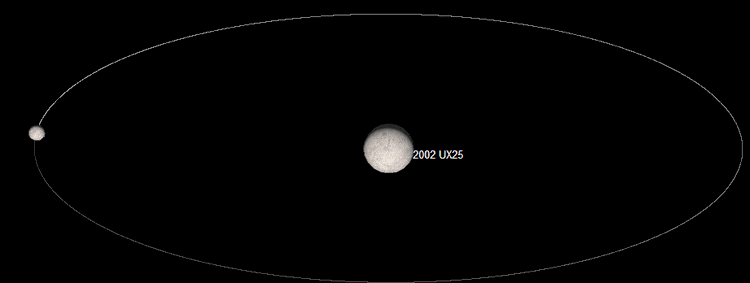MPC designation (55637) 2002 UX25 Aphelion 49 m Orbits Sun | Discovery date 30 October 2002 Discovered 30 October 2002 Inclination 19.484° | |
 | ||
Discovery site Kitt Peak National Observatory Similar (55565) 2002 AW197, (55636) 2002 TX300, (84522) 2002 TC302, (208996) 2003 AZ84, Solar System | ||
55637 2002 ux25
(55637) 2002 UX25 is a possible dwarf planet that orbits the Sun in the Kuiper belt beyond Neptune. Its orbit takes roughly 280 years, and it has one known moon. This moon makes it much easier to calculate Mass, and when the size is known, also a density. The low density of about 0.82 g/cm3 surprised astronomers.
Contents
- 55637 2002 ux25
- Classification
- Dwarf planet status
- Physical characteristics
- Composition
- Satellite
- References
It is a trans-Neptunian object with an absolute magnitude of 4.0, making it highly likely to be a dwarf planet. The Spitzer Space Telescope results estimate it to be about 681 km in diameter. It was discovered on 30 October 2002, by the Spacewatch program. It is a mid-sized cubewano similar in size to 20000 Varuna.
Classification

(55637) 2002 UX25 has a perihelion (closest approach to the Sun) of 36.7 AU, which it will next reach in 2065. As of 2010, (55637) 2002 UX25 is 41 AU from the Sun.
The minor planet Center (MPC) classifies (55637) 2002 UX25 as a cubewano while the Deep Ecliptic Survey (DES) classifies it as scattered-extended. The DES using a 10 My integration (last observation: 2009-10-22) shows it with a minimum perihelion (qmin) distance of 36.3 AU.
(55637) 2002 UX25 has been observed 60 times with precovery images back to 1991.
Dwarf-planet status
(55637) 2002 UX25 has an estimated diameter of 7005665000000000000♠665±29 km, and most icy objects around 400 km in diameter are thought to be spherical. Michael Brown's website lists it as highly likely a dwarf planet. However, light-curve analysis has questioned whether it is actually a dwarf planet.
Physical characteristics
A variability of the visual brightness was detected which could be fit to a period of 14.38 or 16.78 h (depending on a single-peaked or double peaked curve). The light-curve amplitude is ΔM = 6999210000000000000♠0.21±0.06.
The analysis of combined thermal radiometry of (55637) 2002 UX25 from measurements by the Spitzer Space telescope and Herschel Space Telescope indicates an effective diameter of 692 ± 23 km and albedo of 0.107+0.005
−0.008. Assuming equal albedos for the primary and secondary it leads to the size estimates of ~664 km and ~190 km, respectively. If the albedo of the secondary is half of that of the primary the estimates become ~640 and ~260 km, respectively.
(55637) 2002 UX25 has red featureless spectrum in the visible and near-infrared but has a negative slope in the K-band, which may indicate the presence of the methanol compounds on the surface. It is redder than Varuna, unlike its neutral-colored "twin" 2002 TX300, in spite of similar brightness and orbital elements.
Composition
With a density of 0.82 g/cm3, assuming that the primary and satellite have the same density, (55637) 2002 UX25 is one of the largest known solid objects in the Solar System that is less dense than water. Why this should be is not well understood, because objects of its size in the Kuiper belt often contain a fair amount of rock and are hence pretty dense. To have a similar composition to others large KBOs, it would have to be exceptionally porous, which is unlikely given the compactability of water ice. Hence, its density astonished astronomers.
Satellite
The discovery of a satellite of (55637) 2002 UX25 was reported in IAUC 8812 on 22 February 2007. The satellite was detected using the Hubble Space Telescope in August 2005. The satellite was found at 0.16 arcsec from the primary with an apparent magnitude difference of 2.5. It orbits the primary in 7000830899999999999♠8.309±0.0002 days, at a distance of 7006477000000000000♠4770±40 km, yielding a system mass of 7020125000000000000♠(1.25±0.03)×1020 kg. The Eccentricity of the orbit is 6999170000000000000♠0.17±0.03.
This moon is estimated to be 7005210000000000000♠210±30 km in diameter. Assuming the same albedo as the primary, it would have a diameter of 190 km, assuming an albedo of 0.05 (typical of other cold, classical KBOs of similar size) a diameter of 260 km.
